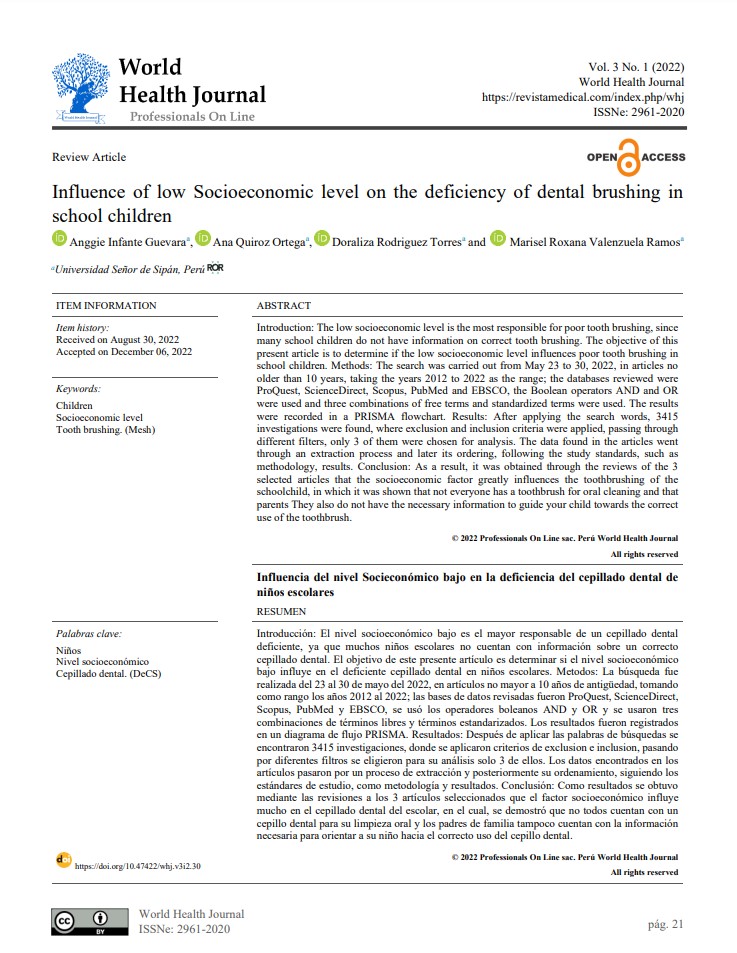Abstract
Introduction: The low socioeconomic level is the most responsible for poor tooth brushing, since many school children do not have information on correct tooth brushing. The objective of this present article is to determine if the low socioeconomic level influences poor tooth brushing in school children. Methods: The search was carried out from May 23 to 30, 2022, in articles no older than 10 years, taking the years 2012 to 2022 as the range; the databases reviewed were ProQuest, ScienceDirect, Scopus, PubMed and EBSCO, the Boolean operators AND and OR were used and three combinations of free terms and standardized terms were used. The results were recorded in a PRISMA flowchart. Results: After applying the search words, 3415 investigations were found, where exclusion and inclusion criteria were applied, passing through different filters, only 3 of them were chosen for analysis. The data found in the articles went through an extraction process and later its ordering, following the study standards, such as methodology, results. Conclusion: As a result, it was obtained through the reviews of the 3 selected articles that the socioeconomic factor greatly influences the toothbrushing of the schoolchild, in which it was shown that not everyone has a toothbrush for oral cleaning and that parents They also do not have the necessary information to guide your child towards the correct use of the toothbrush.
References
Trinh VA, Tarbit E, Do L, Ha D, Tadakamadla SK. La influencia del estatus socioeconómico familiar en las prácticas de cepillado de dientes en niños australianos. J Public Health Dent [Internet]. 2021 [citado el 4 de julio de 2022];81(4):308–15. Disponible en: https://pubmed.ncbi.nlm.nih.gov/34622451/
Verlinden DA, Reijneveld SA, Lanting CI, van Wouwe JP, Schuller AA. Socio-economic inequality in oral health in childhood to young adulthood, despite full dental coverage. Eur J Oral Sci [Internet]. 2019 [citado el 12 de julio de 2022];127(3):248–53. Disponible en: https://pubmed.ncbi.nlm.nih.gov/30791128/
Fernando C, Ha DH, Do LG, Tadakamadla SK. Socioeconomic status and toothbrushing in Indigenous and non-Indigenous Australian children. JDR Clin Trans Res [Internet]. 2022 [citado el 12 de julio de 2022];23800844221086204. Disponible en: https://pubmed.ncbi.nlm.nih.gov/35360957/
Casanova-Rosado AJ, Medina-Solís CE, Casanova-Rosado JF, Vallejos-Sánchez AA, Minaya-Sánchez M, Mendoza-Rodríguez M, et al. Frecuencia de cepillado dental en escolares mexicanos y variables sociodemográficas, socioeconómicas y odontológicas asociadas. Med Sci Monit [Internet]. 2014 [citado el 4 de julio de 2022];20:938–44. Disponible en: https://pubmed.ncbi.nlm.nih.gov/24907713/
Bast LS, Nordahl H, Christensen LB, Holstein BE. Cepillado de dientes entre jóvenes de 11 a 15 años en Dinamarca: efecto combinado de la clase social y el estatus migratorio. Salud Comunitaria Dent [Internet]. 2015 [citado el 4 de julio de 2022];32(1):51–5. Disponible en: https://pubmed.ncbi.nlm.nih.gov/26263593/
S S, M Z. Factores que afectan la higiene oral y el cepillado de dientes en niños en edad preescolar, Shiraz/Irán. J Dent Biomater [Internet]. 2017 [citado el 4 de julio de 2022];4(2):394–402. Disponible en: https://pubmed.ncbi.nlm.nih.gov/28959771/
Tashiro Y, Nakamura K, Seino K, Ochi S, Ishii H, Hasegawa M, et al. El impacto de un programa de cepillado de dientes en la escuela sobre la caries dental: un estudio transversal. Environ Health Prev Med [Internet]. 2019 [citado el 4 de julio de 2022];24(1):83. Disponible en: https://pubmed.ncbi.nlm.nih.gov/31888460/
Cubero Santos A, Lorido Cano I, González Huéscar A, Ferrer García MÁ, Zapata Carrasco MD, Ambel Sánchez JL. Prevalencia de caries dental en escolares de educación infantil de una zona de salud con nivel socioeconómico bajo. Pediatr aten primaria [Internet]. 2019 [citado el 11 de julio de 2022];21(82):e47–59. Disponible en: https://scielo.isciii.es/scielo.php?script=sci_arttext&pid=S1139-76322019000200007
Del M, Herrera S, Lucas-Rincón SE, Medina-Solís CE, Maupomé G, De Lourdes Márquez-Corona M, et al. Desigualdades socioeconómicas en salud bucal: Factores asociados a la frecuencia de cepillado dental en escolares nicaragüenses Rev Invest Clin. 2009. [citado el 11 de julio de 2022]. Disponible en: https://pubmed.ncbi.nlm.nih.gov/20184130/

This work is licensed under a Creative Commons Attribution 4.0 International License.
Copyright (c) 2022 Anggie Infante Guevara, Ana Quiroz Ortega, Doraliza Rodriguez Torres, Marisel Roxana Valenzuela Ramos

